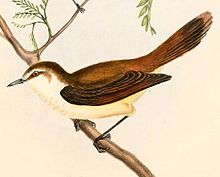Chatham gerygone
| Chatham gerygone | |
|---|---|
 |
|
| Scientific classification | |
| Kingdom: | Animalia |
| Phylum: | Chordata |
| Class: | Aves |
| Order: | Passeriformes |
| Family: | Acanthizidae |
| Genus: | Gerygone |
| Species: | G. albofrontata |
| Binomial name | |
|
Gerygone albofrontata G R Gray, 1844 |
|
The Chatham gerygone or Chatham Island warbler (Gerygone albofrontata) is a species of bird in the family Acanthizidae. It is endemic to the Chatham Islands and thus not found on the mainland, where its relative, the endemic grey warbler (Gerygone igata), is found. The Chatham Island warbler is larger and sports different plumage for the male, female and juvenile birds. Both warblers were discovered and named by G. R. Gray in 1845. The grey and Chatham Island warblers are the only two members of the Australasian family Acanthizidae found in New Zealand.
The Chatham Island warbler has a plain olive-brown head and upperparts, with off-white underparts interrupted by pale yellow flanks and undertail. The male warbler has a distinctive white forehead, eyebrows, throat and underparts. The female warbler lacks these white areas, instead showing dull greyish-white underparts and yellow eyebrows, cheek and throat. Both adults have red eyes. This species of warbler also shows variation in the plumage of the juvenile bird. More akin to the female colouration, the juveniles have olive-grey upperparts and more yellow through their underparts, with brown eyes.
Adult Chatham Island warblers of both sexes are about 12 cm (4.7 in) long, but the male slightly outweighs the female adult, with average weights of 10 g (0.35 oz) and 8.5 g (0.30 oz) respectively.
The call of the Chatham Island warbler is delicate and intricate. The bird song is said to be similar to that heard from grey warblers that haven’t graduated into full song, with initial phrases of four notes recurring throughout the tune. This distinctive call was said to be used by Māori to act as a reminder for when the time came to plant their crops.
Its natural habitat is temperate forests. Widespread in the southern forest of the main Chatham Island, the warblers are also seen on surrounding islands such as Pitt Island, Little Mangere Island, Star Keys, and Rangatira. Habitat loss and predators are the main causes for the northern boundary seen on the main island.
The Chatham Island warbler’s diet consists of small insects such as caterpillars, flies and beetles, and spiders. They feed mainly in the canopy, taking insects from leaves and tree branch crevices, and are also seen to browse the leaf litter. Unlike the grey warbler, the Chatham Island warbler does not hover to collect insects.
...
Wikipedia

